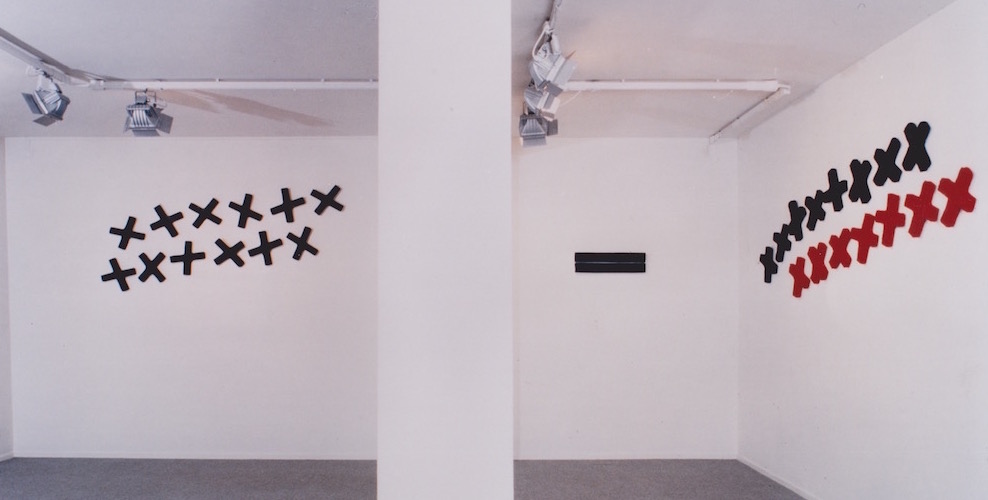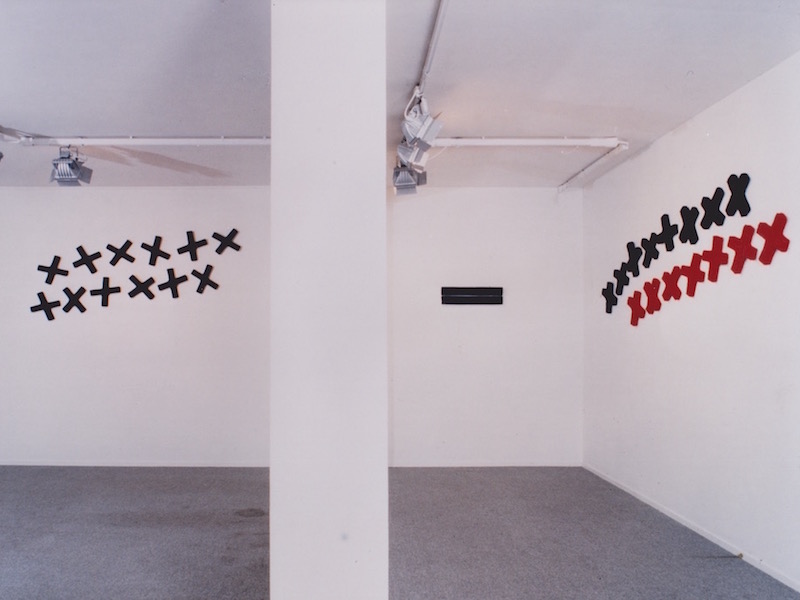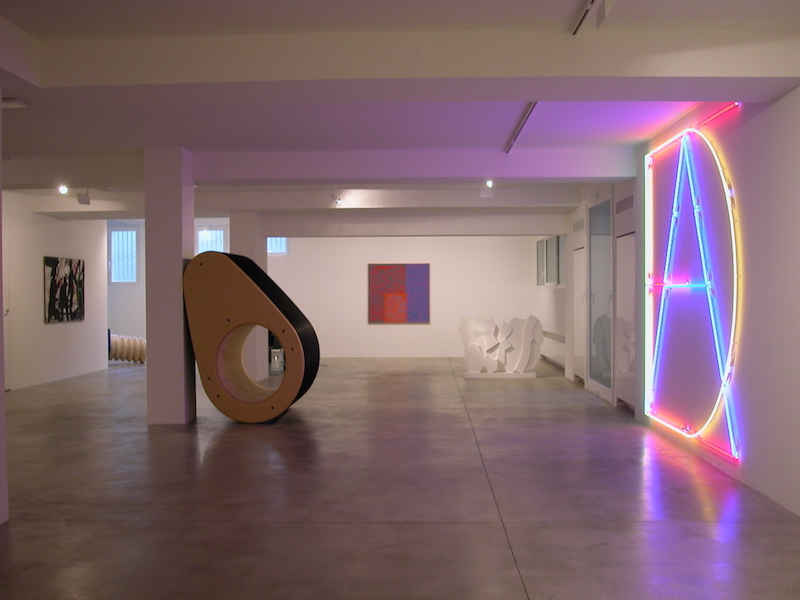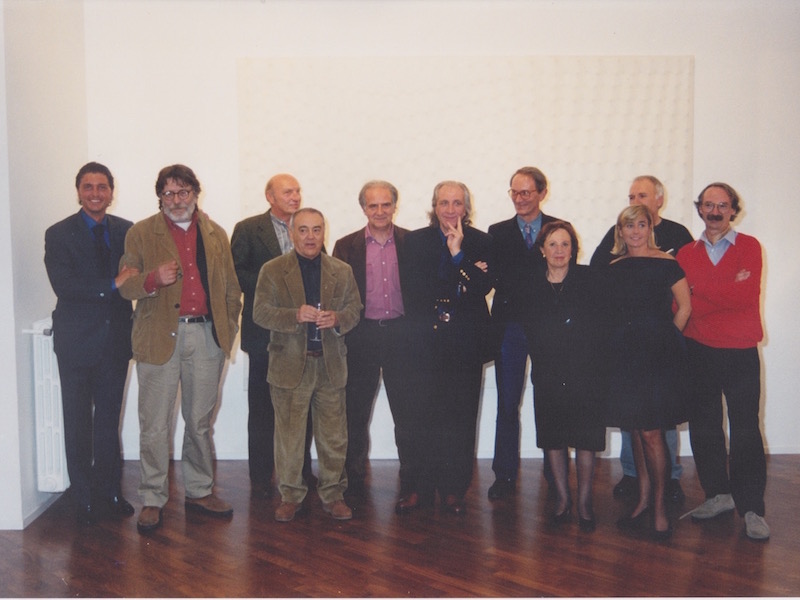PINO PINELLI
PINO PINELLI

Biography
Pino Pinelli was born in Catania in 1938. After completing his artistic studies in his hometown, he moved to Milan where he lives and works since the ‘60s. Since the beginning his research has been focused on the essence of painting, seeking to create a depth in the pictorial surface. The series of “Topologies” and “Monochromes” (1973-1975) belong to this period, their surfaces initially bounded by a thin border line appear to be moved by a ferment. These experiences linked Pinelli’s work to Analytical Painting, named by critic Filiberto Menna. The mid-’70s marked the season of “Dissemination”, when painting reduced to fragments was placed on the wall almost mimicking the gesture of a seeder: the monochromatic and almost sculptural, fragments change over time passing from the rigorous forms of the ’70s to others that seem to swell by a sort of expansion energy and in the late ’80s characterized by lightness and the usual velvet leather that invites tactility.
Pino Pinelli has been exhibiting his works in numerous solos in institutions, such as: Palazzo Reale, Milan and Gallerie d’Italia, Milan (2018), Ducci Foundation, Rome and MARCA, Catanzaro (2017), Multimedia Art Museum, Moscow and Palazzo della Cultura, Catania (2016), Galleria Comunale d’Arte Contemporanea, Arezzo (2014), Rocca Roverasca, Senigallia (2013), Villa La Versiliana, Marina di Pietrasanta (2010), Palazzo Strozzi, Florence (2006), Kunstverein Schloss Lamberg, Steyr and Italian Institute of Culture, London (2001), Civica Galleria d’Arte Moderna, Gallarate (1999), Kunstverein Villa Frank, Ludwigsburg (1995), Palazzo Alborghetti, Osio Sotto and Teatro Sociale, Bergamo (1994), Palazzo Municipale, Morterone (1989). Among the most important collective exhibitions in institutions: Rocca Roveresca, Senigallia (2018), Villa Contarini, Piazzola sul Brenta (2017), Palazzo della Gran Guardia, Verona (2016), Palazzo della Permanente, Milan (2014), Bocconi University, Milan (2013), CAMeC, La Spezia (2012), Museum of Contemporary Art Villa Croce, Genoa (2009), Palazzo della Permanente, Milan (2007), Italian Institute of Culture, Prague (2005), Palazzo Bricherasio, Turin (2003),
Palazzo Rospigliosi, Rome ( 2001), Galleria d’Arte Moderna, Bologna (1998), Nouveau Musée d’Art et d’Histoire, Langres (1997), Palazzo della Permanente, Milan (1995), Palazzo Martinengo, Brescia (1993), Biblioteca Regionale, Palermo (1990), Kunsthalle, Darmstadt (1988), Kunstverein, Frankfurt and Kunstverein, Hannover (1986), Centre National d’Art Contemporain Villa Arson, Nice (1985), Galleria Nazionale d’Arte Moderna, Verona (1982), Palazzo delle Esposizioni, Rome (1981), Musée d’Art Moderne de la Ville de Paris (1978), Galleria Civica d’Arte Moderna, Turin (1977), Galleria Civica, Modena (1976). Pino Pinelli took part in international exhibitions such as Venice Biennale (1997, 1986) and Rome Quadriennale (2005, 1986). His collaboration with Galleria Fumagalli began in 1994 with a personal exhibition, held at the same time of an extensive show in the public Teatro Sociale di Bergamo. In 1999 the gallery organized a second solo show and published a volume with a text by Marco Meneguzzo.
Biography
Pino Pinelli was born in Catania in 1938. After completing his artistic studies in his hometown, he moved to Milan where he lives and works since the ‘60s. Since the beginning his research has been focused on the essence of painting, seeking to create a depth in the pictorial surface. The series of “Topologies” and “Monochromes” (1973-1975) belong to this period, their surfaces initially bounded by a thin border line appear to be moved by a ferment. These experiences linked Pinelli’s work to Analytical Painting, named by critic Filiberto Menna. The mid-’70s marked the season of “Dissemination”, when painting reduced to fragments was placed on the wall almost mimicking the gesture of a seeder: the monochromatic and almost sculptural, fragments change over time passing from the rigorous forms of the ’70s to others that seem to swell by a sort of expansion energy and in the late ’80s characterized by lightness and the usual velvet leather that invites tactility.
Pino Pinelli has been exhibiting his works in numerous solos in institutions, such as: Palazzo Reale, Milan and Gallerie d’Italia, Milan (2018), Ducci Foundation, Rome and MARCA, Catanzaro (2017), Multimedia Art Museum, Moscow and Palazzo della Cultura, Catania (2016), Galleria Comunale d’Arte Contemporanea, Arezzo (2014), Rocca Roverasca, Senigallia (2013), Villa La Versiliana, Marina di Pietrasanta (2010), Palazzo Strozzi, Florence (2006), Kunstverein Schloss Lamberg, Steyr and Italian Institute of Culture, London (2001), Civica Galleria d’Arte Moderna, Gallarate (1999), Kunstverein Villa Frank, Ludwigsburg (1995), Palazzo Alborghetti, Osio Sotto and Teatro Sociale, Bergamo (1994), Palazzo Municipale, Morterone (1989). Among the most important collective exhibitions in institutions: Rocca Roveresca, Senigallia (2018), Villa Contarini, Piazzola sul Brenta (2017), Palazzo della Gran Guardia, Verona (2016), Palazzo della Permanente, Milan (2014), Bocconi University, Milan (2013), CAMeC, La Spezia (2012), Museum of Contemporary Art Villa Croce, Genoa (2009), Palazzo della Permanente, Milan (2007), Italian Institute of Culture, Prague (2005), Palazzo Bricherasio, Turin (2003),
Palazzo Rospigliosi, Rome ( 2001), Galleria d’Arte Moderna, Bologna (1998), Nouveau Musée d’Art et d’Histoire, Langres (1997), Palazzo della Permanente, Milan (1995), Palazzo Martinengo, Brescia (1993), Biblioteca Regionale, Palermo (1990), Kunsthalle, Darmstadt (1988), Kunstverein, Frankfurt and Kunstverein, Hannover (1986), Centre National d’Art Contemporain Villa Arson, Nice (1985), Galleria Nazionale d’Arte Moderna, Verona (1982), Palazzo delle Esposizioni, Rome (1981), Musée d’Art Moderne de la Ville de Paris (1978), Galleria Civica d’Arte Moderna, Turin (1977), Galleria Civica, Modena (1976). Pino Pinelli took part in international exhibitions such as Venice Biennale (1997, 1986) and Rome Quadriennale (2005, 1986). His collaboration with Galleria Fumagalli began in 1994 with a personal exhibition, held at the same time of an extensive show in the public Teatro Sociale di Bergamo. In 1999 the gallery organized a second solo show and published a volume with a text by Marco Meneguzzo.
Exhibitions
SOLO EXHIBITIONS
GROUP EXHIBITIONS
Exhibitions
SOLO EXHIBITIONS
GROUP EXHIBITIONS






